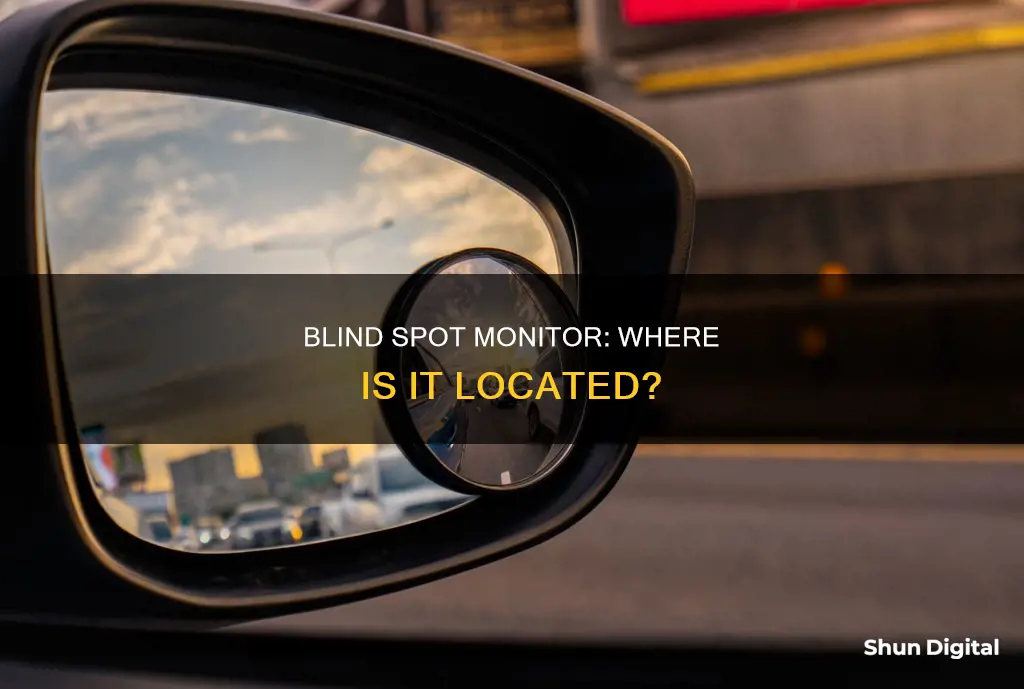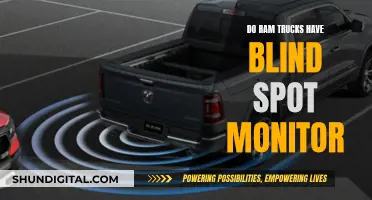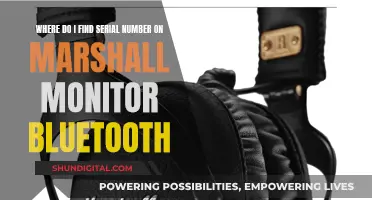
Blind spot monitors are vehicle-based sensor devices that detect other vehicles located to the driver's side and rear. They are usually placed on the mirrors and/or rear bumper of a car and can be visual, audible, vibrating, or tactile. Blind spot monitoring systems use radar or ultrasonic sensors embedded in each side of the vehicle's rear bumper to detect vehicles approaching the rear of the car in an adjoining lane. More advanced systems employ side-mounted cameras and can even autonomously steer the vehicle back into its lane to avoid a collision.
| Characteristics | Values |
|---|---|
| What is it? | A vehicle-based sensor device that detects other vehicles located to the driver's side and rear |
| How does it work? | Uses ultrasonic sensors, radar, cameras, and/or lidar to detect vehicles in blind spots; alerts drivers through visual, audible, vibrating, or tactile warnings |
| Types | Basic systems detect vehicles currently in the blind spot; more advanced systems can predict when a vehicle is about to enter the blind spot |
| When to use | Generally operational at speeds greater than 20 mph; not useful for city streets |
| Limitations | Requires regular cleaning and maintenance of sensors and cameras; may not detect motorcycles or similarly sized objects; not a substitute for safe driving practices |
| Benefits | Prevents accidents, increases driving awareness, enhances safety, improves driver confidence, and reduces stress |
| Installation | Can be factory-installed or aftermarket; professional installation recommended for aftermarket systems |
What You'll Learn

Blind-spot monitoring systems use radar or ultrasonic sensors
Blind-spot monitoring systems are an advanced driving assistance system (ADAS) designed to increase safety by alerting the driver to vehicles that may have escaped visibility in the side-view and rearview mirrors. These systems use radar or ultrasonic sensors to detect vehicles in blindspot areas.
Radar-based systems use radio waves to find objects within their operational range and alert the driver. Radar sensors, unlike other sensors, are not affected by light or darkness and can detect obstructions such as glass and "see" through walls. They can also detect motion and velocity more precisely than ultrasonic sensors. Millimeter-wave radar sensors have an operating frequency of 30 to 300 GHz, which means the emitted electromagnetic wave is on a millimetre scale. This allows the radar to adapt to various climate environments.
Ultrasonic sensors, on the other hand, use sound waves to function. They emit ultrasonic waves that bounce off objects and travel at a known speed. When the waves strike an object, some of their energy reflects back to the sensor's receiver as an echo signal. Ultrasonic sensors are commonly used in parking assistance systems and for detecting obstacles when reversing.
The basic variant of blind-spot monitoring uses ultrasonic sensors or corner radar sensors located inside the left and right sides of the rear bumpers, as well as cameras in the side-view mirror housings. The advanced variant uses two corner radar sensors in the rear bumper, one on the left and one on the right, to monitor the area alongside and behind the car.
When a vehicle enters the blind spot, the driver is typically alerted by a warning sign in the side mirror, such as a flashing light or illuminated icon. Some systems also provide additional warnings, such as an audible beep, a vibrating steering wheel or seat, or tactile feedback. These warnings are triggered when the driver activates the turn signal to change lanes, indicating their intention to manoeuvre.
Blind-spot monitoring systems are especially useful for large trucks and SUVs with long tail ends and poor rear visibility. They are typically operational at speeds greater than 20 mph and are designed to complement safe driving practices, not replace them.
Best Places to Buy Desktop Monitors
You may want to see also

Visual, audible, vibrating, or tactile warnings
Blind-spot monitoring systems are now a common feature of modern cars, and they can provide a range of warnings to the driver. These include visual, audible, vibrating, or tactile alerts.
The most basic systems will use a visual indicator, such as an illuminated icon or flashing light, to indicate that a vehicle is in your blind spot. This will usually be located in the side-view mirror, gauge cluster, or head-up display. This visual alert is often accompanied by an audible warning, such as a beeping tone or repeating chime. Some systems will only provide this audible alert when the driver indicates to change lanes with a turn signal.
Some cars also offer haptic alerts, such as vibration through the steering wheel or seat, to warn the driver of a potential hazard. This is sometimes accompanied by an audible alert.
More advanced systems can also provide autonomous steering or braking to prevent a collision. However, these systems can usually be overridden by the driver.
Identifying Monitor Lizards: Sex Determination Techniques and Tricks
You may want to see also

Blind-spot monitoring is not a substitute for checking mirrors
Blind-spot monitoring is a useful feature that can increase safety on the road. It is a vehicle-based sensor device that detects other vehicles located in a driver's blind spot, which is the area on either side of a car that cannot be seen in the rearview or side-view mirrors.
While blind-spot monitoring is a helpful tool, it is not a substitute for checking mirrors and looking over your shoulder. Here are some reasons why:
Limitations of the Technology
Blind-spot monitoring systems typically only work at speeds above 20-35 mph. This means that their usefulness is limited on city streets and byways, and they are primarily designed for highway use. Additionally, these systems cannot detect passing vehicles travelling at significantly higher speeds and have a maximum speed differential limit. They also may not detect smaller objects, such as motorcycles.
Human Error and System Malfunction
Blind-spot monitoring systems are designed to compensate for human error, but they are not perfect. Drivers must still take responsibility for their driving and use safe practices. For example, the sensors and cameras of the monitoring system must be kept clean and clear of obstructions like snow, ice, mud, dirt, or condensation to function correctly.
False Sense of Security
While blind-spot monitoring can provide valuable assistance, it is important for drivers to remain actively engaged in the driving process. Relying solely on the system may lead to a false sense of security and potentially increase the risk of an accident.
Complementary Tools
Blind-spot monitoring is most effective when used in conjunction with other tools and safe driving practices. This includes adjusting side-view mirrors properly to eliminate blind spots, using turn signals, and glancing over your shoulder before changing lanes. By combining these practices with blind-spot monitoring, drivers can benefit from an additional layer of safety.
In conclusion, while blind-spot monitoring is a valuable feature that can enhance safety, it should not be relied upon exclusively. Drivers should continue to check their mirrors, use turn signals, and remain vigilant to ensure a safe driving experience for themselves and others on the road.
Connecting a Monitor to Your Fender Passport Venue
You may want to see also

Blind-spot monitoring systems are now standard on affordable models
Blind-spot monitoring systems typically use ultrasonic sensors or radar, along with cameras, to detect vehicles in a driver's blind spots. These sensors are usually located on the car's flanks or embedded in the rear bumper. When a vehicle enters the blind spot, the system alerts the driver through visual, audible, or tactile warnings. Visual warnings may include a blinking light on the corresponding side mirror or a notification on the driver's display. Audible alerts, such as beeping or clicking noises, are often paired with visual cues to emphasize the potential danger. Some systems also offer tactile alerts, such as vibrating the steering wheel or the driver's seat.
While blind-spot monitoring systems are a valuable safety feature, they are not a substitute for proper mirror adjustment, shoulder checks, and safe driving practices. Drivers should still use their turn signals, watch their mirrors, and look over their shoulders when changing lanes. Additionally, these systems have limitations, such as speed restrictions and an inability to detect all types of objects. It is important for drivers to understand the capabilities and limitations of their vehicle's blind-spot monitoring system and use it as a supplementary tool to their own safe driving practices.
The inclusion of blind-spot monitoring systems as a standard feature in affordable vehicles demonstrates the increasing accessibility of advanced driver assistance systems. This technology not only enhances safety but also provides drivers with greater peace of mind and confidence while executing manoeuvres such as merging or changing lanes. With its ability to reduce accidents and minimize driving stress, blind-spot monitoring is becoming an essential feature for modern vehicles.
Monitoring Comcast Data Usage: Tips and Tricks
You may want to see also

Aftermarket blind-spot monitoring systems are available
Aftermarket blind spot monitoring systems use sensors, including radar, sonar, and lidar, to detect objects in a vehicle's blind spots. Some systems also use cameras inserted into the side mirrors to relay information to a computer. Once the system detects an object, it alerts the driver through visual, audible, or haptic means.
There are two main types of blind spot monitoring systems: aftermarket and factory-installed. Aftermarket systems are custom-designed by start-up companies and major auto parts companies, and they are generally compatible with most vehicles, regardless of age, make, and model. They are also less expensive and easier to repair than factory-installed systems.
Factory-installed blind spot monitoring systems, on the other hand, are provided by automotive manufacturers as a standard or upgraded feature. They are often custom-tailored for specific models and are rarely compatible with older cars. These systems are more credible and durable but come at a higher cost.
The cost of aftermarket blind spot monitoring systems can vary depending on the type and accuracy of the system. The most affordable systems cost $250 or less, while mid-range systems range from $250 to $500. The higher-end systems cost $500 or more and offer the highest reliability and accuracy.
It is important to note that blind-spot monitoring systems are not a replacement for safe driving habits. They should be used as an additional safety measure to compensate for human error.
OLED Monitor Buying Guide: Is It Worth It?
You may want to see also
Frequently asked questions
The blind spot monitor is located on the sides of a vehicle, usually on the side mirrors or the rear bumpers.
A blind spot monitoring system can help prevent accidents and increase a driver's awareness. It can also provide peace of mind and make the driving experience more comfortable.
A blind spot monitoring system uses radar, ultrasonic sensors, or cameras to detect vehicles or other objects in a driver's blind spot. When an object is detected, the system alerts the driver through visual, auditory, or haptic cues.







